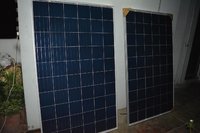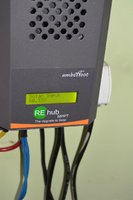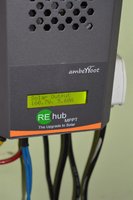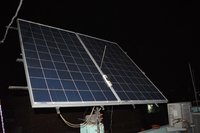You are using an out of date browser. It may not display this or other websites correctly.
You should upgrade or use an alternative browser.
You should upgrade or use an alternative browser.
CyberKID
In search for Tech Gyan!
And finally, (just about) the moment I have been working towards, for close to three years now, and have been planning on for around 8 years - Powering up my solar power plant!
*i.imgur.com/AUWwvpc.png
Both the panels, eagerly waiting to be mounted on the tracker rig.
*i.imgur.com/sVmYzX7.png
*i.imgur.com/ZDqqwdr.png
*i.imgur.com/TX1oXAv.png
Though, I still haven't mounted the panels on the tracker rig, since it needs some time and lots of man power to mount that ~50 kilogram assembly on the tracker rig, hopefully, this will be done tonight.
*i.imgur.com/AUWwvpc.png
Both the panels, eagerly waiting to be mounted on the tracker rig.
*i.imgur.com/sVmYzX7.png
*i.imgur.com/ZDqqwdr.png
*i.imgur.com/TX1oXAv.png
Though, I still haven't mounted the panels on the tracker rig, since it needs some time and lots of man power to mount that ~50 kilogram assembly on the tracker rig, hopefully, this will be done tonight.
Attachments
CyberKID
In search for Tech Gyan!
Waking up this long dead thread. Finally, after years of tiring work, literally pulling my hair out, for days altogether, and over all these months, I can finally say that my Dual Axis Solar Tracker is functional now. The tracking works good in good sunlight. The tracker does not need any human interference in the normal circumstances. The platform too is quite stable now.
What does this mean? This means I have now achieved the basic functionality that was expected from the Dual-Axis Solar Tracker. Both the axes now work in good tandem with each other, none misbehaving, or working out of synchronization. The basic hardware and the tracker rig has now been setup, and from here on, there can only be improvements.
*geek.digit.in/community/attachments/dsc_0743-custom-jpg.17109
So, pictured above is the tracker rig along with both the panels mounted and the sensor assembly visible in between. The sensor assembly sends the information related to the sun light to the MPU (Arduino Uno in this case), which processes the information, and sends the instructions to the motor driver, which in turn drives both the DC motors to align the panels perpendicular to the sun. The one below, in that clear box houses MPU and the Motor Driver.
What does this mean? This means I have now achieved the basic functionality that was expected from the Dual-Axis Solar Tracker. Both the axes now work in good tandem with each other, none misbehaving, or working out of synchronization. The basic hardware and the tracker rig has now been setup, and from here on, there can only be improvements.
*geek.digit.in/community/attachments/dsc_0743-custom-jpg.17109
So, pictured above is the tracker rig along with both the panels mounted and the sensor assembly visible in between. The sensor assembly sends the information related to the sun light to the MPU (Arduino Uno in this case), which processes the information, and sends the instructions to the motor driver, which in turn drives both the DC motors to align the panels perpendicular to the sun. The one below, in that clear box houses MPU and the Motor Driver.
Attachments
CyberKID
In search for Tech Gyan!
Thanks for the suggestion, mate. The plan is to move to an Arduino Mega based WeMos (built on Arduino Mega Platform, comprises of an ESP8266 on the board itself). ESP will allow Datalogging on a remote webserver, that can be used for a). Realtime to near-Realtime monitoring of the rig and performance tracking. Why we are moving to an Arduino Mega is wehave planned to build this as an entirely autonomous system that, for most parts does not need human intervention for any of it's daily O&M. b). Possibility of remote control of the Tracking Rig, if human intervention is needed at all, over the internet, set/change certain configuration parameters, if the need be.awesome job cybo, now that its working, convert the tracking controller from arduino to esp8266 or esp32 & access all the tracking settings and info real time on mobile fone !
c). Local User Interface to control the tracking rig, in case human intervention is required.
All these will need dozens of sensors, both Analogue and Digital, for which I'll be needing dozens of I/O ports on the MCU.
CyberKID
In search for Tech Gyan!
Yes, am quite sure. Have explored a lot of options including ESP826612-A, NodeMCU, Arduino Uno, Arduino Nano and Finally the Mega. What I need is a combination of Analogue and Digital I/O pins. Analogue pins are important. Uno has six of them, Nano has eight of them, ESP12-A has two. NodeMCU was something considerable, but it's too complicated to program and make use of. Did explore the possibility of using a Rasp Pi as well. So just went off with the hybrid Mega+ESP. I do not want to use an ADC, as adding more components makes it hard to troubleshoot.
I have a lot of Analogue sensors, 4 pins for the light sensors for tracking, two will always be used as SDA and SCL, for things like an RTC and LCD, running on the IIC bus. Then one for a DHT 11/22 for temperature/Humidity, another one for voltage measurement, and yet another for current measurement. One more for an anemometer and then, if it further allows, a rain sensor.
I have a lot of Analogue sensors, 4 pins for the light sensors for tracking, two will always be used as SDA and SCL, for things like an RTC and LCD, running on the IIC bus. Then one for a DHT 11/22 for temperature/Humidity, another one for voltage measurement, and yet another for current measurement. One more for an anemometer and then, if it further allows, a rain sensor.
Last edited:
kARTechnology
Sony " VA" "IO"
Yes, am quite sure. Have explored a lot of options including ESP826612-A, NodeMCU, Arduino Uno, Arduino Nano and Finally the Mega. What I need is a combination of Analogue and Digital I/O pins. Analogue pins are important. Uno has six of them, Nano has eight of them, ESP12-A has two. NodeMCU was something considerable, but it's too complicated to program and make use of. Did explore the possibility of using a Rasp Pi as well. So just went off with the hybrid Mega+ESP. I do not want to use an ADC, as adding more components makes it hard to troubleshoot.
I have a lot of Analogue sensors, 4 pins for the light sensors for tracking, two will always be used as SDA and SCL, for things like an RTC and LCD, running on the IIC bus. Then one for a DHT 11/22 for temperature/Humidity, another one for voltage measurement, and yet another for current measurement. One more for an anemometer and then, if it further allows, a rain sensor.
you could get the esp8266 wemos and a MCP3008...to get analog + digital I/O
and initially use ubidots to send and control, view the data too.
and it can run standard arduino code as well as the new Lua ones which is more advanced imo, but as async capability.
CyberKID
In search for Tech Gyan!
Thanks for the suggestions, mate. For now, I think we are sorted out, the prototype PCB has been built around the Mega. Let's see what comes up next.you could get the esp8266 wemos and a MCP3008...to get analog + digital I/O
and initially use ubidots to send and control, view the data too.
and it can run standard arduino code as well as the new Lua ones which is more advanced imo, but as async capability.
Update: 18-12-2017
While I am currently in testing mode to have a better understanding of environmental conditions throughout the varying seasons, and how to mitigate the unfavorable conditions, like sudden cloud cover, to ensure that the system keeps working as independently as I ever wanted. The test rig is still based on the Uno, has the minimal add-ons since my motive is to make the system better able to adapt and respond to the sunlight conditions.





